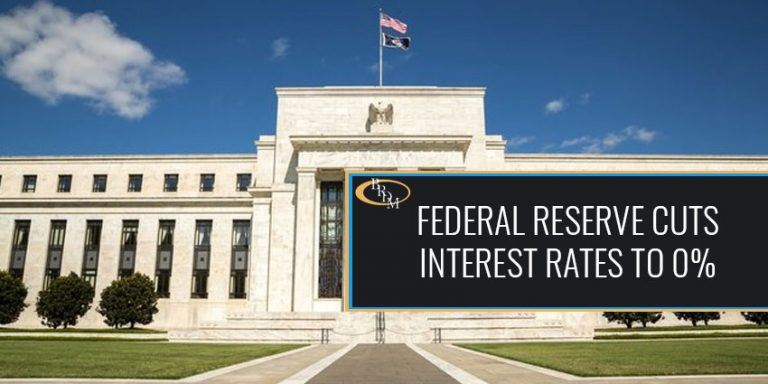In an effort to combat the negative economic implications of the Coronavirus (COVID-19), the Federal Reserve made the decision this past weekend to cut interest rates to 0% for the first time since the financial crisis of 2008. This emergency rate cut is the second significant rate cut made this year in response to the Coronavirus which has caused the world great distress over the past few months and even more so in the United States in recent weeks. The first rate cut by the Federal Reserve in response to Coronavirus came only a few weeks ago when the Federal Reserve elected to cut the Fed Funds Rate by .5% or 50 basis points. The second rate in response to the Coronavirus cut came this past Sunday and effectively took the Federal Funds Rate to 0%. When the Federal Reserve makes a rate cut it decreases the interest rate of the “Fed Funds Rate” which represents the interest rate at which banks and other depository institutions lend money to each other. Indirectly, a cut in the Fed Funds Rate will generally equate to lower interest rates in other lending sectors which includes mortgage rates. While the Fed Funds Rate does not directly affect the rate at which Banks offer mortgages to borrowers, many lenders generally take their cue from the Federal Reserve and the Fed Funds Rate when determining at what rate to loan funds. Therefore, a lowering in the Fed Funds Rate will generally equate to or influence lower mortgage rates. The actions recently taken by the Federal Reserve will likely present a significant opportunity for both current and prospective homeowners to either refinance their current mortgage or purchase a new home with borrowed funds at a historically low interest rate.
In the coming weeks or months, I project that homeowners will be able to borrow money at the lowest rates since “The Great Recession” and quite possibly some of the lowest rates this nation has ever seen. Taking advantage of these low interest rates would allow homeowners the ability to lock in a low rate for up to 30 years which equates to thousands of dollars saved over the term of a long-term mortgage loan. For those who are unfamiliar with the process, when you refinance your mortgage at a lower interest rate, you apply for and procure a loan in an amount that pays off your existing higher rate mortgage. The higher rate mortgage is then satisfied and the new lower rate mortgage replaces the old. The result is considerable interest savings in the long run.
Refinancing can also be a tool used to consolidate higher interest rate debt like credit card or student loan debt; this technique is known as the “Cash-Out Refinance.” St. Petersburg, Tampa, Clearwater, the Tampa Bay Area, Pinellas County, and Hillsborough County have experienced substantial price appreciation in real estate over the past 10 years. If you bought your home more than a year ago, chances are that the value of your property has increased and you have significant equity. If you have debt you would like to pay off, you can borrow against the equity in your home to pay off high interest debt while refinancing your higher interest rate mortgage at today’s lower interest rates. This technique would allow you to eliminate your high interest debt, which could be 15%+ interest and instead pay that amount over 30 years at a rate of 4% interest or lower. The run up in real estate values and the recent interest rate cuts presents an excellent opportunity for someone looking for a fresh start by eliminating existing debt.
- Business & Corporate
- Criminal Law
- Estate Planning
- Business Succession Planning
- Charitable Trusts and Donative Planning
- Dynasty Trusts
- Family Limited Partnerships
- Family Trusts
- Homestead & Real Estate Issues
- Intra-Family Loans & Installment Sales
- Irrevocable Trusts
- Lady Bird Deeds
- Life Insurance Trusts (ILITs)
- Limited Liability Companies
- Medicaid Eligibility Planning
- Revocable Trusts
- Supplemental Needs Trusts
- Trust Formation & Funding
- Will Preparation
- Litigation
- 1st Amendment Litigation
- Administrative Litigation
- Alternate Dispute Resolution
- Business Litigation
- Corporate Litigation
- Civil Litigation
- Commercial Litigation
- Computer and Software Litigation
- Construction Litigation
- Corporate & Partnership Disputes
- Employment Contract Litigation
- Financial Institution Litigation
- Insurance & Bad Faith Litigation
- Intellectual Property Litigation
- Intentional Torts
- Probate and Trust Litigation
- Professional Liability Litigation
- Real Estate Litigation
- Securities Litigation
- Trade Secrets Litigation
- Personal Injury
- Bicycle Accidents
- Boating Accidents
- Brain Injuries
- Burn Injuries
- Car Accidents
- Commercial Vehicle Accidents
- Construction Accidents
- Dog Bites
- Drunk Driving Accidents
- Golf Cart Accidents
- Hit and Run Accidents
- Medical Malpractice
- Moped Accidents
- Motorcycle Accidents
- Negligent Security
- Pedestrian Accidents
- Premises Liability
- Products Liability
- PSTA Bus Accidents
- Scooter Accidents
- Slip And Fall Accidents
- Tesla Accidents
- Truck Accidents
- Uber & Lyft Accidents
- Wrongful Death
- Property Damage
- Real Estate
- Probate & Trust Admin
- Business & Corporate
- Criminal Law
- Estate Planning
- Business Succession Planning
- Charitable Trusts and Donative Planning
- Dynasty Trusts
- Family Limited Partnerships
- Family Trusts
- Homestead & Real Estate Issues
- Intra-Family Loans & Installment Sales
- Irrevocable Trusts
- Lady Bird Deeds
- Life Insurance Trusts (ILITs)
- Limited Liability Companies
- Medicaid Eligibility Planning
- Revocable Trusts
- Supplemental Needs Trusts
- Trust Formation & Funding
- Will Preparation
- Litigation
- 1st Amendment Litigation
- Administrative Litigation
- Alternate Dispute Resolution
- Business Litigation
- Corporate Litigation
- Civil Litigation
- Commercial Litigation
- Computer and Software Litigation
- Construction Litigation
- Corporate & Partnership Disputes
- Employment Contract Litigation
- Financial Institution Litigation
- Insurance & Bad Faith Litigation
- Intellectual Property Litigation
- Intentional Torts
- Probate and Trust Litigation
- Professional Liability Litigation
- Real Estate Litigation
- Securities Litigation
- Trade Secrets Litigation
- Personal Injury
- Bicycle Accidents
- Boating Accidents
- Brain Injuries
- Burn Injuries
- Car Accidents
- Commercial Vehicle Accidents
- Construction Accidents
- Dog Bites
- Drunk Driving Accidents
- Golf Cart Accidents
- Hit and Run Accidents
- Medical Malpractice
- Moped Accidents
- Motorcycle Accidents
- Negligent Security
- Pedestrian Accidents
- Premises Liability
- Products Liability
- PSTA Bus Accidents
- Scooter Accidents
- Slip And Fall Accidents
- Tesla Accidents
- Truck Accidents
- Uber & Lyft Accidents
- Wrongful Death
- Property Damage
- Real Estate
- Probate & Trust Admin



